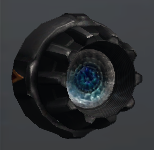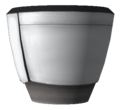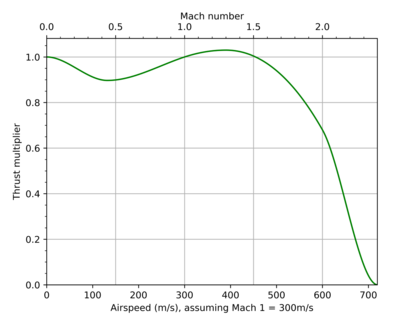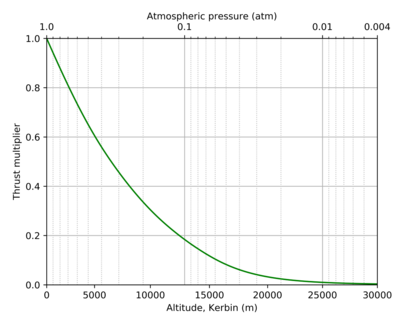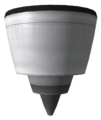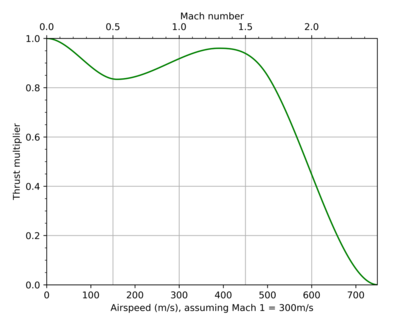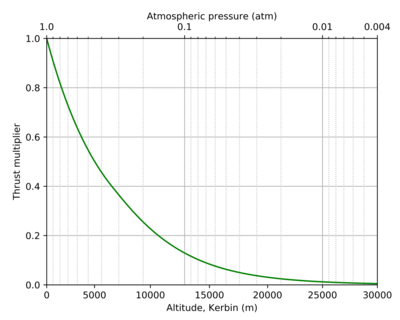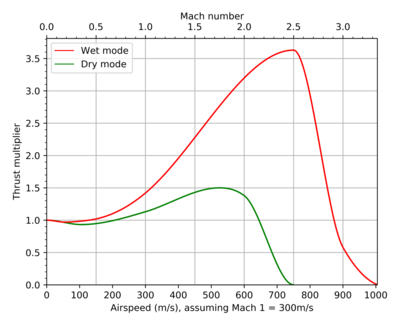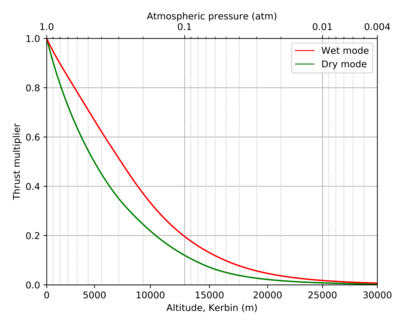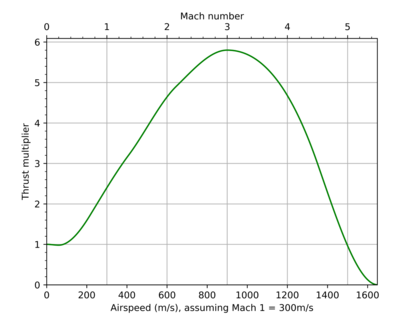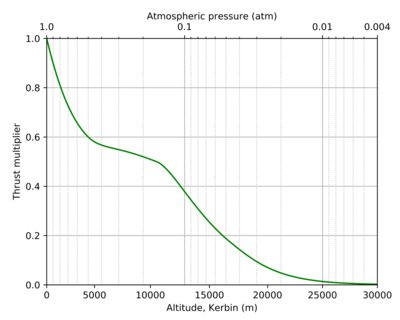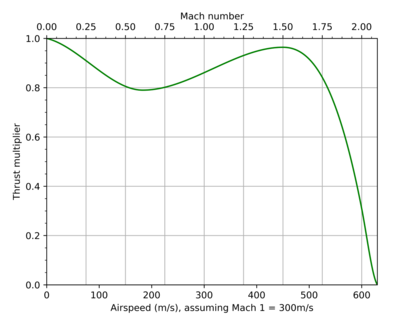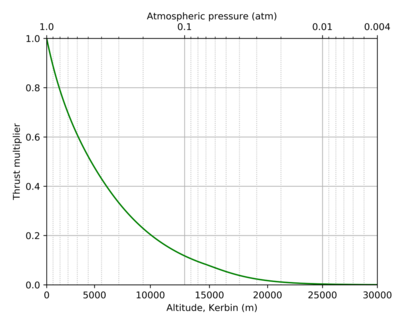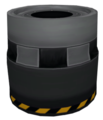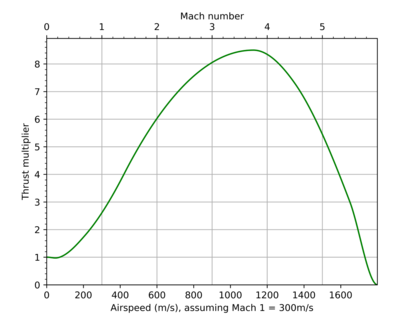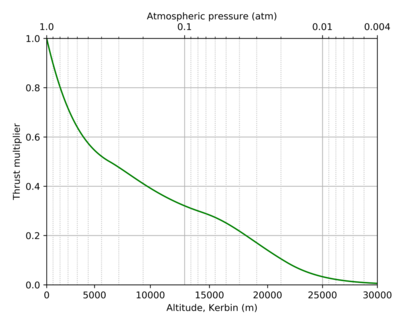Difference between revisions of "Jet engine"
m (→Usage: *use version template;) |
m (Removed first person usage) |
||
| (15 intermediate revisions by 11 users not shown) | |||
| Line 1: | Line 1: | ||
| − | [[ | + | [[File:JetEngine.png|right|thumb|A jet engine from KSP 0.18]] |
| − | A '''jet engine''' is an air-breathing engine which uses onboard [[liquid fuel]] and combusts it with the oxygen drawn from the [[atmosphere]]. Due to the lower air pressure at higher altitudes its thrust output | + | A '''jet engine''' is an air-breathing engine which uses onboard [[liquid fuel]] and combusts it with the [[oxygen]] drawn from the [[atmosphere]]. Due to the lower air pressure at higher altitudes its thrust output decreases accordingly. |
| + | |||
| + | Technically, any [[w:rocket engine|rocket engine]] is also a jet engine as it forms a high-speed jet of [[w:reaction mass|reaction mass]]. But for KSP players, the term is limited to engines dependent on [[intake air]]. | ||
== Usage == | == Usage == | ||
| − | Unlike [[rocket engine]]s, a jet draws oxygen from the atmosphere rather than taking it from an on-board tank. This is represented in-game by a much lower rate of fuel consumption. Depending on the aircraft, jet engines can produce thrust at altitudes greater than 20 km. Jet engines do not perform in the same manner as rocket engines. Since Jet engines rely on a turbine to compress fuel and atmosphere together in order to produce thrust, it takes time to change speed. Also if the [[throttle]] or air flow are too low the engine will stall. By contrast, rocket engines give instant response to control input. | + | Unlike [[rocket engine]]s, a jet draws oxygen from the atmosphere rather than taking it from an on-board tank. This is represented in-game by a much lower rate of fuel consumption. Depending on the aircraft, jet engines can produce thrust at altitudes greater than 20 km. Unlike in earlier versions, each jet engine has its ceiling height, regardless of intake air provided. Jet engines do not perform in the same manner as rocket engines. Since Jet engines rely on a turbine to compress fuel and atmosphere together in order to produce thrust, it takes time to change speed. Also if the [[throttle]] or air flow are too low the engine will stall. By contrast, rocket engines give instant response to control input. |
[[File:Jet engine flame out.png|thumb|The flame out effect on a [[Basic Jet Engine]]]] | [[File:Jet engine flame out.png|thumb|The flame out effect on a [[Basic Jet Engine]]]] | ||
| − | As of {{Version|0.18}} jet engines require [[intake air]] to run, provided by [[air intake]]s. Jet engines don't consume [[oxidizer]], so the use of [[ | + | As of {{Version|0.18}} jet engines require [[intake air]] to run, provided by [[air intake]]s. Jet engines don't consume [[oxidizer]], so the use of [[rocket fuel tank]]s is very wasteful because they come with an full oxidizer tank adding additional mass. When the intake air level isn't checked periodically a jet engine tends to flame out and suddenly doesn't generate any thrust. As this may happen unevenly it can cause severe spinning and potential loss of the craft. Jet engines also produce heat. |
| + | |||
| + | One large difference of the jet engines compared to conventional rocket engines is, that the thrust also greatly depends on the velocity relative to the atmosphere around. As of {{Version|1.0.5}}, the 6 jet engines can be divided into low-speed and high-speed engines, regarding their thrust-to-speed behaviour. The three low-speed engines do not gain thrust with speed, but rather lose about 20% around mach 0.5, gaining about full thrust again at around mach 1.5, dropping sharply to zero around mach 2. The three high-speed engines on the other hand gain a considerable ammount of thrust up to their design speed, gradually lowering to zero approaching its high top speed. The thrust gain, design speed and max speed increases with thech level, up to 850% gain at mach 3.7 on the [[R.A.P.I.E.R. Engine|R.A.P.I.E.R.]]. However, as more thrust most often leads to more velocity ( leading to more thrust ...) this behaviour should be considered at the more advanced engines, as it can easily lead to a [[Catastrophic failure|rapid unscheduled disassembly]]. | ||
| + | |||
| + | {{FlipBox|style=word-wrap: normal;margin: 0em 0em 0.5em; border-style: solid solid solid solid; padding: 0px; background-color: #FFFFFF; border-color:#aaaaaa; border-width:1px; width: 69em; | ||
| + | |title=the velocity and atmosphere curves of the jet engines | ||
| + | |content= | ||
| + | {{Stats table jet engines - curves}} | ||
| + | }} | ||
| + | |||
| + | I<sub>sp</sub> of all jet engines is unaffected by speed and height, which is different from pre {{Version|1.0}} behaviour as well as from rocket engines. Thus, the fuel consumption varies according to thrust output. | ||
== Advantages == | == Advantages == | ||
* Provides excellent fuel efficiency within an atmosphere | * Provides excellent fuel efficiency within an atmosphere | ||
| − | * | + | * The high speed jet engines provide thrust vectoring for greater maneuverability |
| − | * Excellent power to weight ratio | + | * Excellent power to weight/size ratio |
== Disadvantages == | == Disadvantages == | ||
Latest revision as of 23:10, 11 October 2023
A jet engine is an air-breathing engine which uses onboard liquid fuel and combusts it with the oxygen drawn from the atmosphere. Due to the lower air pressure at higher altitudes its thrust output decreases accordingly.
Technically, any rocket engine is also a jet engine as it forms a high-speed jet of reaction mass. But for KSP players, the term is limited to engines dependent on intake air.
Usage
Unlike rocket engines, a jet draws oxygen from the atmosphere rather than taking it from an on-board tank. This is represented in-game by a much lower rate of fuel consumption. Depending on the aircraft, jet engines can produce thrust at altitudes greater than 20 km. Unlike in earlier versions, each jet engine has its ceiling height, regardless of intake air provided. Jet engines do not perform in the same manner as rocket engines. Since Jet engines rely on a turbine to compress fuel and atmosphere together in order to produce thrust, it takes time to change speed. Also if the throttle or air flow are too low the engine will stall. By contrast, rocket engines give instant response to control input.

As of version 0.18 jet engines require intake air to run, provided by air intakes. Jet engines don't consume oxidizer, so the use of rocket fuel tanks is very wasteful because they come with an full oxidizer tank adding additional mass. When the intake air level isn't checked periodically a jet engine tends to flame out and suddenly doesn't generate any thrust. As this may happen unevenly it can cause severe spinning and potential loss of the craft. Jet engines also produce heat.
One large difference of the jet engines compared to conventional rocket engines is, that the thrust also greatly depends on the velocity relative to the atmosphere around. As of version 1.0.5, the 6 jet engines can be divided into low-speed and high-speed engines, regarding their thrust-to-speed behaviour. The three low-speed engines do not gain thrust with speed, but rather lose about 20% around mach 0.5, gaining about full thrust again at around mach 1.5, dropping sharply to zero around mach 2. The three high-speed engines on the other hand gain a considerable ammount of thrust up to their design speed, gradually lowering to zero approaching its high top speed. The thrust gain, design speed and max speed increases with thech level, up to 850% gain at mach 3.7 on the R.A.P.I.E.R.. However, as more thrust most often leads to more velocity ( leading to more thrust ...) this behaviour should be considered at the more advanced engines, as it can easily lead to a rapid unscheduled disassembly.
| Part | Velocity curve(s) | Atmosphere curve(s) |
|---|---|---|
|
|
||
|
|
||
|
|
||
|
|
||
|
|
||
|
|
Isp of all jet engines is unaffected by speed and height, which is different from pre version 1.0 behaviour as well as from rocket engines. Thus, the fuel consumption varies according to thrust output.
Advantages
- Provides excellent fuel efficiency within an atmosphere
- The high speed jet engines provide thrust vectoring for greater maneuverability
- Excellent power to weight/size ratio
Disadvantages
- Cannot be used outside of an atmosphere that contains oxygen. In current version, it means they only function on Kerbin and Laythe.
- Thrust output changes depending on speed
- Engine requires time to spool up to maximum thrust potential
Available jet engines
| Image | Part | Radial size | Cost ( |
Mass (t) |
Max. Temp. (K) |
Tolerance (m/s) |
Tolerance (g) |
Thrust (kN) |
TWR | Fuel ( |
Intake ( |
Isp (s) | TVC (°) |
Reverse |
|---|---|---|---|---|---|---|---|---|---|---|---|---|---|---|
| J-20 "Juno" Basic Jet Engine | Tiny | 450 | 0.25 | 2 000 | 7 | 50 | 20.0 Mach 0 20.6 Mach 1.3 |
8.16 Mach 0 8.40 Mach 1.3 |
0.064 | 1.402 | 6 400 | — | No | |
| J-33 "Wheesley" Turbofan Engine | Small | 1 400 | 1.5 | 2 000 | 7 | 50 | 120.0 Mach 0 | 8.16 Mach 0 | 0.233 | 29.601 | 10 500 | — | Yes | |
| J-404 "Panther" Afterburning Turbofan | Small | 2 000 | 1.2 | 2 000 | 7 | 50 | 85.00 Mach 0 107.89 Mach 1.75 / 130.00 Mach 0 219.48 Mach 2.5 |
7.22 Mach 0 9.17 Mach 1.75 / 11.05 Mach 0 18.65 Mach 2.5 |
0.193 / 0.663 |
7.705 / 7.954 |
9 000 / 4 000 |
10.0 | No | |
| J-X4 "Whiplash" Turbo Ramjet Engine | Small | 2 250 | 1.8 | 2 000 | 7 | 50 | 130.00 Mach 0 386.66 Mach 3.0 |
7.36 Mach 0 21.90 Mach 3.0 |
0.663 | 5.303 | 4 000 | 1.0 | No | |
| J-90 "Goliath" Turbofan Engine | Radial mounted | 2 600 | 4.5 | 2 000 | 7 | 50 | 360.0 Mach 0 | 8.16 Mach 0 | 0.583 | 132.273 | 12 600 | — | Yes | |
| CR-7 R.A.P.I.E.R. Engine[Note 1] | Small | 6 000 | 2.0 | 2 000 | 20 | 50 | 105.00 Mach 0 465.64 Mach 3.75 |
5.35 Mach 0 23.74 Mach 3.75 |
0.669 | 4.015 | 3 200 | 3.0 | No |
- ↑ The R.A.P.I.E.R. Engine is a combination of liquid fuel and jet engine. Only the jet engine properties are shown.
See also
- Jet engine on Wikipedia
